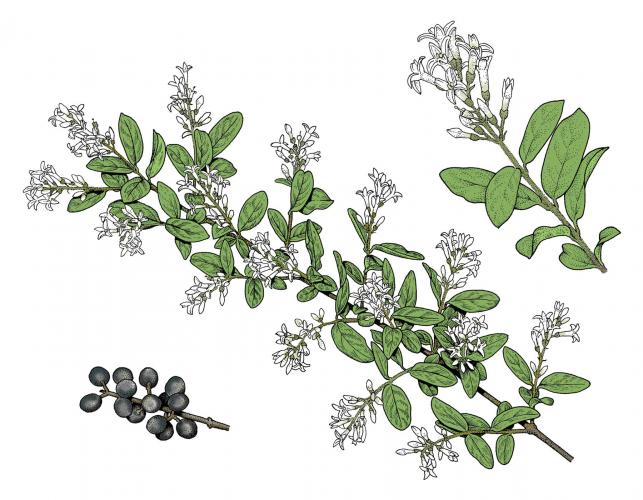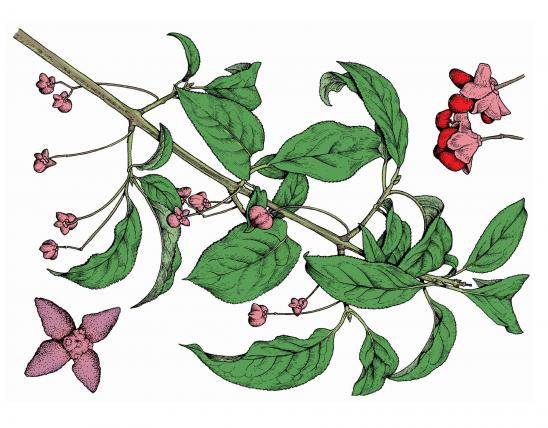
Four species of privets occur in Missouri, all are nonnative, and all are considered invasive or potentially invasive. When they invade natural habitats, they can form dense thickets that crowd out native vegetation. They were all introduced for use as landscaping shrubs. Some species are more invasive than others, but because the different species are rather hard to tell apart, it is wise to not use any of them. Instead, select native shrubs, which have more value for wildlife and do not harm native habitats.
Privets are in the genus Ligustrum, and the ones that occur in Missouri are all evergreen or semi-evergreen shrubs with few to several trunks.
Leaves are opposite, with short or very short leaf stalks. Blades simple, ½–3 inches long, ¼–1 inch wide, oblong, oval, or egg-shaped, sometimes lance-shaped, with a blunt or sharp tip, margins not toothed, upper surface green to dark green, smooth, undersurface lighter or more yellow, smooth or hairy.
Flowers develop after the leaves, in clusters at branch tips, usually in many-flowered panicles that may be ¾–4 inches long. Flowers are white or whitish, trumpet-shaped, to about ½ long, with 4 petal lobes; calyx tube unlobed or with 4 very shallow lobes; flowers are unpleasantly fragrant. All four species in Missouri bloom May–June, with California privet also blooming into July.
Fruits berrylike drupes, ¼–½ inch long, globe-shaped to slightly ovoid, green to olive green, turning bluish black or black, smooth, sometimes slightly waxy-white coated. Usually in small clusters of 2–6 or more, varying with species. Fruits develop August–September.
Four nonnative privets have been recorded as escaping from cultivation and growing in Missouri’s natural habitats:
- Border privet (L. obtusifolium) has twigs (at least when young) with short hairs, and petal tubes with the tube slightly longer than to about 3 times as long as the lobes, with the green sepal tube also short-hairy. Scattered mostly south of the Missouri River. Native of Asia. Commonly escapes from cultivation. Grows in bottomland forests, mesic to dry upland forests, glades, and banks of streams, spring branches, and rivers; also in old fields, ditches, railroads, roadsides, and disturbed areas.
- California privet (L. ovalifolium) has glabrous (smooth, hairless) twigs, and petal tubes with the tube 2–3 times as long as the lobes. In Missouri, the first recordings of this species have been in southeastern border counties (Butler, Howell, and Ripley). Despite the common name, it is a native of Asia. Grows on edges of fens and in mesic upland forests; also on roadsides and banks of ditches.
- Chinese privet (L. sinense) has twigs (at least when young) with short hairs, and petal tubes with the tube shorter than to about as long as the lobes, with the sepals smooth (glabrous) or nearly so. Scattered mostly south of the Missouri River, especially in the Bootheel lowlands. Native of Asia. Grows in bottomland forests, mesic upland forests, bottomland prairies, margins of sand prairies, and banks of streams and rivers; also in old fields, old homesites, ditches, railroads, roadsides, and disturbed areas. This species is especially capable of forming dense stands in forest understories and has a history of spreading aggressively in the Gulf Coastal Plain. Although it was initially cultivated as an ornamental, it is no longer popular because it spreads too aggressively.
- Common privet or European privet (L. vulgare) has glabrous (smooth, hairless) twigs (though minutely hairy when young), and petal tubes with the tube shorter than to about as long as long as the lobes, or, if the twigs are hairy with tiny, spreading hairs, then the leaf blades are smooth and hairless (glabrous). Widely scattered. Native of Europe. Usually occurs in old homesites and disturbed areas, but also along banks of spring branches. This is the most widely planted privet species for hedges east of Missouri, and there are numerous cultivars.
Similar species: Several other species of privet are also cultivated as ornamentals in North America, including Amur privet (L. amurense), Japanese or wax-leaf privet (L. japonicum), glossy privet (L. lucidum), and waxyleaf privet (L. quihoui). Also, privets are often sold in the form of cultivars with variegated leaves of green and white or green and yellow.
Swamp privet (Forestiera acuminata) is similar in name and is in the same family. It resembles spicebush (Lindera benzoin) when it blooms in early spring. It is native, scattered in eastern Missouri, mostly in the Bootheel lowlands and counties bordering the Mississippi River, north to Pike County; there’s also a disjunct range in southwestern Missouri. Usually occurs in small stands, as it sprouts from the roots. A straggly shrub or small tree growing in wet to swampy ground, its flowers appear March–April, before the leaves, on the stem of the previous year’s growth, the male flowers in dense yellow or greenish-yellow clusters above yellow bracts (no true petals), thus resembling clusters of yellowish stamens. The leaves are toothed, with a pointed tip and the bases narrowly wedge shaped.
Height: not taller than about 16 feet. The smaller species are border privet (usually only to 7 feet) and California privet (usually only to about 10 feet). It’s not unusual for the other two species to attain 16 feet. In cultivation, these species are frequently kept trimmed to smaller sizes.
Potentially statewide. All four species have been found in Missouri. They are spreading, and experts who study invasive plants project they will soon have a major negative impact.
Habitat and Conservation
Planted as landscape shrubs and escaping initially into thickets, edges of woods, and disturbed sites.
Currently, privets are most common in and near urban and suburban areas, but they are expanding rapidly into natural habitats. The four species vary in how aggressive they are, but most people have a hard time distinguishing among the species. None are native to Missouri, they offer little to wildlife, and none belong in natural plant communities.
Status
Nonnative shrubs used in landscaping. At least four different species. None are native to Missouri. Commonly escape from cultivation. Invasive or potentially invasive.
The Missouri Invasive Plant Council has labeled nonnative, invasive privets as one of the top invasive plants in Missouri. They caution that, for nearly all the privet species, there is insufficient data on current abundance and distribution in the state, and how rapidly their ranges are expanding — so it is difficult to predict the severity of environmental degradation they’ll cause. The experience of nearby states indicates that some species, especially border privet (L. obtusifolium), will become very problematic. In Missouri, it has been spreading rapidly since its first detection in our state in the early 1990s.
It is already clear that border privet currently has a high number of escaped populations in the many counties along the Missouri River from central Missouri to the eastern border, and then south along the Mississippi. Within that area, the species is expanding its range rapidly, and it is projected to cause an especially severe degree of environmental degradation in that area.
The degree of aggressive invasiveness of a privet varies by the species, but all have been found escaping into nature in our state. Experts warn that the extent of escapes is currently underreported. Several states near Missouri have been experiencing a shocking spread of some of these species. Unfortunately, once invasive plants have made inroads in an area, it is especially difficult (and costly) to try to control them.
Human Connections
Privets have long been popular in horticulture as background shrubs, windbreaks, hedges, and specimen plants. Their dense, evergreen foliage, kept trimmed, was used as a kind of living fence, to mark boundaries or as part of a high-maintenance, formal landscaping design. Unfortunately, invasive tendencies in nonnative plants are sometimes slow to be seen.
Many nonnative landscaping plants are prized because they are bothered by few insect pests. At first, that seems like a great idea, but a plant that doesn’t feed many insects also isn’t contributing much to the food chain. Caterpillars and other insects are bird food. People are starting to realize that it’s okay to have caterpillars chew up some of their plants’ leaves, and they're opting to plant native species.
Instead of nonnative, invasive privets, plant native shrubs. In addition to being interesting and beautiful, they offer more value for insects, birds, and other wildlife. Here are some native shrubs to consider: black chokeberry, American beautyberry, New Jersey tea, deciduous holly, spice bush, ninebark, lanceleaf buckthorn, Carolina buckthorn, fragrant sumac, common elderberry, arrowwood viburnum, nannyberry viburnum, blackhaw, and rusty blackhaw.
The chemical that gives privet flowers their unappealing ammonia-like or rotting-fish smell is methylamine, and this has been reported as a source of off-putting flavors in honey when foraging bees visit privet flowers.
Various privet species have been reported as toxic to humans and livestock, but there are conflicting reports on the degree of toxicity. Symptoms of poisoning, apparently caused primarily by terpenoid glycosides, include digestive maladies such as vomiting and diarrhea as well as paralysis, fluid in the lungs, and possibly even death.
Ecosystem Connections
Dense stands of privets produce thousands of fruits, which are eaten by birds such as waxwings, bluebirds, and sparrows. These later poop out the seeds into natural habitats, and this is how privets spread.
Like bush honeysuckles and Callery pears, privets can grow in dense stands, outcompeting native plants. These invasive species typically leaf out early in spring and retain their leaves long into the fall, shading out wildflowers and other native species, and reducing the natural variety of plants in an area. Because insects are often closely linked with specific food plants, insect diversity drops in areas where invasive shrubs are rampant. And fewer insects means less food for nesting birds. A prime reason why many tropical birds migrate to temperate North America is to take advantage of our seasonal blooming of insect populations. Insects are a high-protein diet for breeding birds and their rapidly growing young.
Honeybees, butterflies, and other insects may visit the flowers (see Human Connections for comments on privet’s ill effect on honey flavor). Certain types of moth caterpillars, beetles, aphids, scales, thrips, and other insects may feed on various kinds of privets. Japanese beetles may chew on privets.
Few mammals browse the foliage due to its toxicity.
Globally, there are about 45 species in genus Ligustrum, and the group is native to Europe, Africa, Asia, and south to Australia. None are native to the New World. This genus is in the olive family; other members of the olive family that you might be familiar with are the ashes, lilacs, forsythia, and, of course, true olive.
































